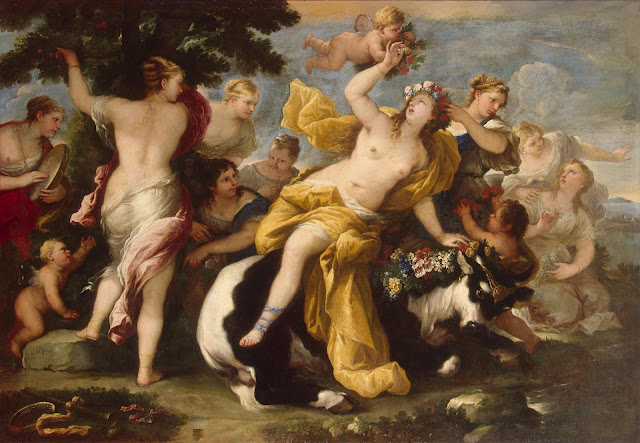 |
| Luca Giordano Self-portrait in the guise of an Alchemist 1660 oil on canvas Pinacoteca di Brera, Milan |
 |
| Luca Giordano Fall of the Rebel Angels ca. 1660-65 oil on canvas Kunsthistorisches Museum, Vienna |
 |
| Luca Giordano St Michael ca. 1663 oil on canvas Gemäldegalerie, Berlin |
 |
| Luca Giordano Venus presenting Arms to Aeneas ca. 1680-82 oil on canvas Museum of Fine Arts, Boston |
"In the seventeenth century Naples had emerged as an art centre of primary importance. It was also in Naples that the most vital contribution was made to the future course of grand decorative painting. Briefly, the new type of fresco painting derived from a fusion of Venetian colourism with Pietro da Cortona's grand manner, which on its part owed much of its vitality to Venice. This synthesis of Rome and Venice was accomplished by the prodigious Luca Giordano (1634-1705), who must be regarded as the quintessence of the new epoch, although most of his work belongs to the seventeenth century. The prototype of the itinerant artist, he travelled up and down Italy, working in Rome, Florence, Venice, and Bergamo, and for ten years was court painter in Madrid (1692-1702). The speed with which he produced his grand improvisations was proverbial ('Luca Fa Presto'). Perhaps the first virtuoso in the eighteenth-century sense, he considered the whole past an open book to be used for his own purposes. He studied Dürer as well as Lucas van Leyden, Rubens as well as Rembrandt, Ribera as well as Veronese, Titian as well as Raphael, and was capable of painting in any manner he chose. But he never copied, a fact noticed by his contemporaries (Solimena). He played with all traditions rather than being tied to one, and his personal manner is always unmistakable. Whatever he did, his light touch and the brio and verve of his performance carry conviction, while his unproblematical and joyous interpretation of subjects anticipates the spirit of the eighteenth century. Clearly, the purpose of painting for him was delight. In Rome and Venice his influence became extraordinarily strong, and on the international stage the effect of his art can hardly be overestimated. He immensely attracted his Neapolitan successors by his typically southern grandiloquent manner and telling rhetoric, qualities one associates with the next fifty years of grand decorative painting in his native city."
– Rudolf Wittkower, Art and Architecture in Italy 1600-1750, originally published in 1958, revised by Joseph Connors and Jennifer Montagu and reissued by Yale University Press in 1999
 |
| Luca Giordano Holy Family venerated by St Anthony of Padua ca. 1664-65 oil on canvas Pinacoteca di Brera, Milan |
 |
| Luca Giordano Flight into Egypt before 1705 oil on canvas Metropolitan Museum of Art, New York |
 |
| Luca Giordano Communion of the Apostles ca. 1680 oil on canvas Museum of Fine Arts, Boston |
 |
| Luca Giordano Ecce Homo ca. 1659-60 oil on canvas Pinacoteca di Brera, Milan |
 |
| Luca Giordano Descent from the Cross ca. 1659 oil on canvas Museo de Santa Cruz, Toledo, Spain |
 |
| Luca Giordano Entombment ca. 1690 oil on canvas Museum of Fine Arts, Boston |
 |
| Luca Giordano St Sebastian tended by St Irene ca. 1665 oil on canvas Philadelphia Museum of Art |
 |
| Luca Giordano Samson and the Lion ca. 1695-96 oil on canvas Museo del Prado, Madrid |
 |
| Luca Giordano Samson destroying the Philistines ca. 1695-96 oil on canvas Museo del Prado, Madrid |
 |
| Luca Giordano Abduction of Europa ca. 1675-77 oil on canvas Hermitage, Saint Petersburg |